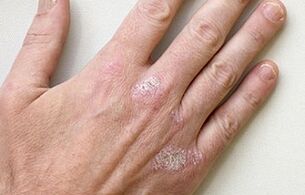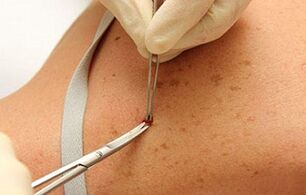Psoriasis is a chronic skin condition. It manifests itself in the form of rashes. The initial stage is characterized by symptoms similar to the clinical picture of other pathologies of the epidermis. In order to prevent the progression of the disease and to facilitate its course, it is necessary to differentiate the pathology. To do this, you need to know the symptoms and manifestations of psoriasis in the various sections.
Causes in Adults and Children
Why does psoriasis occur in children and adults has not been figured out exactly by doctors. There is only speculation as to the cause of this disease. So there is an assumption that psoriasis can be inherited: people whose parents have had such a skin condition often have a psoriasis rash. Some physicians associate the development of pathology with immunological instability, metabolic abnormalities, and the presence of a chronically current infection. In most patients, doctors experience severe hyperlipidemia.
You should perform a classical genome analysis to check for susceptibility to such disease. Those with ten chromosome loci are more likely to develop psoriasis. The main genome responsible for congenital predisposition is PSORS1.
Psoriasis can develop at any age: children, young men and women, the elderly. Doctors say the following factors provoke the disease in adults:
- low immunity;
- chronic fatigue;
- alcohol consumption;
- severe stress;
- poor hygiene;
- constant overeating;
- insect bites;
- infectious pathologies (influenza, ARVI);
- vaccination;
- temperature difference;
- vitamin deficiency;
- smoking;
- long-term medication;
- burning;
- allergy;
- hormonal imbalance;
- climate change;
- malnutrition.
Children most often experience psoriatic outbreaks:
- after sore throat;
- if you have a chronic infection in your body;
- with low immunity.
Psoriasis cannot be started:People with this diagnosis increase the risk of early atherosclerotic vascular changes and heart disease. There is also a risk of arthritis.
Psoriasis is most common in people with poor heredity.
How does psoriasis manifest itself

Psoriasis is characterized by the appearance of large plaques on the skin. The spots are initially insignificant and appear on those parts of the body where the skin is rougher (elbows, knees). Such formations peel off. When scratched, wounds appear that turn pale in the morning.
The disease is characterized by the following manifestations:
- stearinfol.These are tiny scaly papules melted into plaques.
- Terminal film.There are thin, bright pink skin beneath the plaques of psoriasis. Your doctor will see it after you remove all the scales.
- Accurate bleeding(bloody dew syndrome). If the final foil is damaged due to scraping of the stratum corneum of the epidermis, blood droplets appear.
Such manifestations of the aggregate are called a psoriatic triad. They are detected during a sample of the inflamed skin surface.
Psoriasis also has the following symptoms:
- formation of new papules in case of skin damage and increase in the area of the lesion; The elements of rash
- have a dense structure;
- has a red border around the plaque;
- weakness;
- the presence of a whitish, three-millimeter pseudo-atrophic rim around the rash;
- purulent odor from the skin (when pustules form);
- is a phenomenon of oily formation in which a yellowish-brown spot appears under the nail plate;
- proliferative acanthosis, in which the skin thickens, interpapillary processes are prolonged; Symptom of
- throat (nail psoriasis);
- rüh.
Because psoriasis is a chronic pathology, after a while its symptoms begin to disappear and the wounds heal. But then the papules re-form.
First symptoms of the disease
A rash always occurs in the first stage of psoriasis.
At first, almost invisible, with no characteristic scales. Several rash spots appear on the limbs.

In a few weeks, the number of affected areas will increase. The rash merges into large plaques covered with silvery scales. The itching is moderate in the early stages of psoriasis. A person complains of chronic fatigue, weakness.
Such symptoms include allergic skin reactions, dermatitis, and shingles. Therefore, it is important to perform a differential diagnosis.
During the examination, the doctor discovers the psoriasis triad. Depending on the size of the rash, the doctor determines the etiology of psoriasis: drop-shaped, punctate, or coin-shaped.
Signs of a progressive stage of the disease
As the disease progresses, the number of papules increases and the rash spreads to healthy areas of the body. The slightest scratch, bump, or burn will cause a nodular rash. The second stage lasts a long time. By touch, you may find dense boundaries between the inflamed areas of the epidermis. The plaques have an edge that stands out with a vibrant color and is covered with scales.
In the last stage of the disease, the symptoms gradually disappear. The signs become lighter, their borders fade. After a while, the papules disappear, dry skin and hyperpigmented spots remain in place.
The temperature of psoriasis can only rise if inflammatory processes and acne rupture. Then the affected areas can hurt.
What is the stearinfolt phenomenon
Stearin spots are the main symptoms that form the triad of psoriasis. This is a small area where there are papular elements of the rash that are strongly flaky. The more the doctor scratches the affected skin, the more exfoliation appears. During manipulation, the person does not experience pain. The phenomenon got its name because the removable skin flakes look like stearin stains.
Where it first appears: localizing rashes
Initially, psoriatic outbreaks develop on the elbows, legs, and knees. The papules then spread to the thinner and finer areas of the body: the lower leg, the lower back, the wrist, the abdomen, the groin area, the scalp. The rash can be localized elsewhere. But psoriasis is most commonly affected in these areas of the body.
In the absence of proper treatment, the disease spreads to nails, mucous membranes, joints.
Localization of psoriasis rash in adults may include:
- Head. Rashes can be observed on the scalp, ears, back of the head, eyebrows, eyelids, eyes, nasolabial folds.
- Lower limbs.
- Elbow. Scaly plaques form that roughen over time.
- Upper limbs. A small rash similar to a hives occurs.
In children, the rash usually appears as follows:
- legs;
- buttocks;
- skin folds;
- elbow;
- is the scalp.
How does the scaly scalp on your head begin
Scaly lichens can spread throughout the body. Usually acute. A rash develops from pearls to peas. The papula is covered with silvery and white scales. The rash increases over time, merging into one focus with uneven edges. The boundary of this plaque is clear. When the scalp is affected by psoriasis, a psoriasis crown forms: red pustules with purulent content appear behind the ear and along the forehead.
How quickly the pathology develops
The rate at which psoriasis develops depends on its form. Thus, drop-shaped pathology is distinguished by the ability to appear and disappear suddenly. Severe plaque psoriasis is characterized by a gradual spread of pustules throughout the body. The rash is then covered in scaly scales in a short time. The rash merges to form large plaques.
Diagnostic Methods

If psoriasis is suspected, consult a dermatologist. The doctor makes a presumptive diagnosis based on the complaints and examination of the patient. The doctor gives a referral for laboratory, instrumental research. They also perform differential diagnostics.
When the disease progresses, it is recommended that blood be given for analysis to detect an acute, autoimmune, or rheumatic process. In severe situations, a biopsy is also performed, which shows the accumulation of Rete’s body, layer thickening, skin infiltration with polyblasts, T lymphocytes, dendritic cells, increased angiogenesis under psoriasis plaques.
To make a differential diagnosis, do the following:
- allergy test;
- serum biochemistry test;
- analysis of dysbiosis feces; Histological examination of
- biopsy.
No special tests are needed to diagnose psoriasis in children. Pathology is detected by examining the elements of the rash.
How to treat psoriasis
Because psoriasis is a chronic condition, it cannot be completely cured. The goal of therapy is to achieve stable remission and eliminate complications. To do this, use medicine, physiotherapy, folk methods. In severe cases, the patient is hospitalized. In the initial stage, the therapy can be performed at home.
Therapy Clinic
To treat psoriasis lesions, doctors prescribe antihistamines to relieve swelling, itching, and redness.

Enzymatic agents are also used. They stimulate the body to produce the necessary enzymes. Damage to the skin of the body causes discomfort and tightness.
Recognizing that a disease is incurable causes psychological problems. Therefore, doctors prescribe sedative medications to help restore emotional state.
Hepatoprotectors are used to improve liver function. Inflammation and itching can be relieved with non-steroidal anti-inflammatory drugs. Immunomodulators are prescribed to strengthen the body.
Physiotherapy techniques are also used. They help remove pigmentation and speed healing. Doctors recommend:
- selective herbal medicine;
- laser effect on the skin;
- ultrasound treatment;
- magnetotherapy.
In a hospital, the patient is kept under the constant supervision of doctors. Therefore, it is easy to monitor the effectiveness of the prescribed treatment regimen, to modify the applied therapy in time.
Home treatment
Treatment is continued after discharge from the hospital. To maintain normal health and achieve stable remission, doctors prescribe a number of medications in one course. Vitamin complexes, ointments, folk remedies are used.
It is recommended that the patient treat hormonal and non-hormonal ointments daily on the skin areas affected by psoriasis.
Dermatologists prescribe vitamins to improve the condition of the epidermis. Vitamins A, E, D, and C are especially helpful in the fight against psoriasis, which strengthen the body’s defenses, help restore and cleanse the skin.

Traditional healers recommend the use of activated carbon. One of the main causes of psoriasis is metabolic disorders, poisoning. Activated carbon acts as an absorbent, so it cleanses the body well of harmful substances. It should be taken twice a day for 1 month at a dose of 1 tablet / kg body weight.
White clay helps restore skin. Relieves inflammation, dries, removes itching. Baths made with the addition of sea salt are also useful.
There are several guidelines for treating psoriasis at home:
- Take the medicine prescribed by your doctor in the prescribed dose.
- Treat skin with ointments and creams.
- After softening, carefully remove the bark.
- Take air and sunbathe.
- Avoid stressful situations.
- Follow your daily routine, your diet.
- Relax enough.
- Take breaks while taking medication.
By following these recommendations, one can avoid relapse.
Thus, psoriasis is a serious chronic disease. The reasons for its formation could not be determined precisely, only provocative factors are known. The disease has characteristic symptoms, but in the first stage it is similar to other skin pathologies. To identify the disease in time and begin treatment, you should contact a dermatologist when a suspected rash appears.























